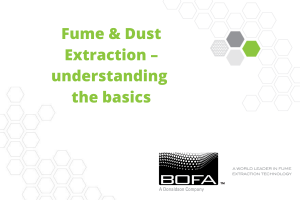Fume & Dust Extraction – understanding the basics
 Why is fume and dust extraction needed?
Why is fume and dust extraction needed?
Fume extraction technology plays an important role in helping companies both manage workplace environments and improve productivity.
Portable systems developed by BOFA help to filter potentially harmful airborne emissions that can result from certain industrial processes, including 3D printing, laser cutting, engraving and coding, PCB manufacture, and printing.
Airborne contaminants can include both particles (including nanoparticles) and gases (including volatile organic compounds) and fume filtration technology will help employers to implement their workplace environment health strategies. A correctly installed and maintained filtration system can also make a positive contribution to productivity by filtering dust and particulate that might otherwise contaminate equipment and potentially lead to downtime.
The first step in assessing risk is to make reference to the material’s Safety Data Sheet to understand the nature of any emissions associated with any given process, while also checking the local regulations governing any workplace exposure levels.
At BOFA, we have considerable experience working with industries to find the most appropriate filtration solution for given processes. We can help identify the type, volume, size, shape, and velocity of particles being emitted and provide filtration system options for managers to consider.
How does BOFA technology help keep workplaces safe?
BOFA’s fume and dust filtration technology has proven to effectively help in filtering airborne contaminants when matched to an appropriate industrial process. And because BOFA equipment is portable, it can support an agile manufacturing environment.
BOFA solutions incorporate a suction pump that draws airborne emissions into advanced filtration technology. This filtration system includes patented DeepPleat DUO pre-filtration, a main High-Efficiency Particulate Air (HEPA) filter and a layer of activated carbon to remove vapours and gases. The exact configuration, airflow rates, and filtration media will depend upon each application and the industrial process involved.
What are the core functions of the key components?
DeepPleat DUO pre-filter technology incorporates a large capacity drop-out chamber to filter high volumes and a variety of particulate in advance of the main HEPA filter. This system helps optimise the life of the HEPA filter.
Gases or vapours can be filtered and retained via a layer of activated carbon.
Airflow is also an important element in extraction performance. BOFA’s automatic airflow functionality allows operators to pre-set airflow rates for specific applications, helping to optimise HEPA filter lifecycles.
Reverse-flow air technology can also contribute to filter performance. It facilitates a fall in velocity and an air direction change, meaning larger particulate falls out of the airstream into the drop-out chamber. With less particulate entering the filter media, the filter life is optimised.
Does the filtration system vary according to application?
BOFA systems are designed to deal with process-specific emissions, including 3D printing, laser marking, ink jet coding, soldering, laser cutting and engraving, electronics soldering, and hand and mechanised grinding. Each solution takes account of the processes, substrates, and chemical interaction.
Are employers generally aware of their responsibilities?
Around the world, the trend is towards rigorous enforcement of workplace exposure levels. BOFA technology can be a key contributor to workplace environmental health programmes, while at the same time helping deliver productivity gains by helping keep process lines free from fume and dust.


